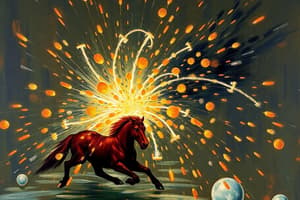Podcast
Questions and Answers
What is the purpose of using a spring balance tool?
What is the purpose of using a spring balance tool?
- To measure the force used (correct)
- To increase the shape of objects
- To measure the velocity of motion of objects
- To change the direction of motion of objects
What type of force arises when an object is placed perpendicularly to the surface?
What type of force arises when an object is placed perpendicularly to the surface?
- Frictional Force
- Tension Force
- Normal Force (correct)
- Spring Force
Which of the following is an example of action-at-a-distance force?
Which of the following is an example of action-at-a-distance force?
- Tension Force
- Normal Force
- Gravitational Force (correct)
- Frictional Force
What is the SI unit for force?
What is the SI unit for force?
What is the definition of resultant force?
What is the definition of resultant force?
According to the definition of motion, what changes if an object is moving?
According to the definition of motion, what changes if an object is moving?
What type of motion occurs when an object travels in a straight line?
What type of motion occurs when an object travels in a straight line?
What is the difference between speed and velocity?
What is the difference between speed and velocity?
What is acceleration, according to the definition?
What is acceleration, according to the definition?
What is the difference between distance and displacement?
What is the difference between distance and displacement?
Flashcards are hidden until you start studying
Study Notes
Force
- A push or pull that can cause changes in the shape of objects, direction of motion, and velocity of motion of objects.
- Measured using a spring balance tool.
- SI unit is the newton (N).
Resultant Force
- The total or overall force acting on a system.
- The sum of all forces acting on an object or system.
Types of Forces
- Contact Forces:
- Frictional Force
- Tension Force
- Normal Force
- Spring Force
- Non-Contact Forces (Action-at-a-distance forces):
- Gravitational Force
- Electrical Force
- Magnetic Force
- Weight Force
Normal Force
- A reaction force that arises when an object is placed perpendicularly to a surface.
- Acts in response to an object's weight or applied force.
Definition of Motion
- Motion is defined as a change in distance or position between an object and a reference point.
- The motion of an object is relative and depends on the observer and the reference point used.
Types of Motion
- Linear motion: motion in a straight line.
- Circular motion: motion along a circular path or part of a circle.
- Parabolic motion: motion along a parabolic trajectory.
- Irregular motion: motion with irregular trajectories.
Uniform Motion
- Uniform motion is defined as motion with a constant velocity in a straight line.
- The distance traveled by an object in uniform motion remains the same.
Distance and Displacement
- Distance is the total length of the path traveled by an object from the initial position to the final position.
- Displacement is the shortest distance between the initial and final positions of an object, measured by drawing a straight line.
- Displacement is a vector quantity, while distance is a scalar quantity.
Speed and Velocity
- Speed is the distance traveled by an object per unit time.
- Speed is a scalar quantity with only magnitude and units.
- Velocity is the displacement per unit time, with both magnitude and units, and direction of motion.
- Velocity is a vector quantity.
Acceleration
- Acceleration is the rate of change of velocity with respect to time.
- Accelerations are vector quantities, having both magnitude and direction.
Studying That Suits You
Use AI to generate personalized quizzes and flashcards to suit your learning preferences.




